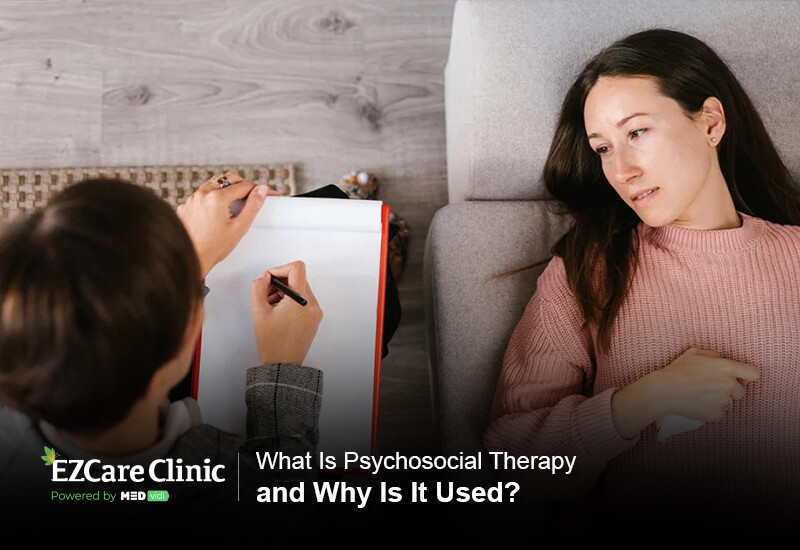Highlights
- Psychomotor agitation (PMA) involves restlessness, irritability, and excessive movement that is involuntary and purposeless.
- PMA is not a standalone diagnosis but a symptom of different mental and neurological conditions such as bipolar disorder, anxiety disorders, PTSD, schizophrenia, depression, etc.
- Immediate coping strategies include deep breathing, grounding techniques, journaling, and physical activity. Long-term treatment depends on the underlying condition.
- If PMA becomes severe, disrupts daily life, or poses a risk to oneself or others, professional medical evaluation and treatment are necessary.
Psychomotor agitation (PMA) is defined by heightened motor activity, irritability, and restlessness. Picture someone being unable to sit through a meeting, constantly tapping their foot, or a person in a waiting room pacing back and forth or fidgeting in their chair — and this happens not out of boredom, but because their bodies simply don’t allow them to be still.
During a period of psychomotor agitation, a person can’t remain calm and makes repetitive, purposeless, or unintentional movements, which emerge as a response to heightened anxiety. They also experience mental tension and altered cognitive function.
The manifestations of PMA can vary in severity, with some requiring medical attention. So, let’s explore the examples of psychomotor agitation, the feelings behind it, potential causes, and the signs that it’s time to seek help.
What Is Psychomotor Agitation?
There is a complex interplay between cognitive processes, sensory perceptions, emotional states, and motor behaviors. Whether you are driving a car, throwing a ball, or playing a musical instrument, your cognitive and physical functions work simultaneously.
The term “psychomotor” refers to how mental processes in the brain influence physical movement. You won’t notice anything unusual when these processes run smoothly. However, when there are disruptions or abnormalities in psychomotor performance, there are observable changes in behavior. For example, they may affect gross and fine motor activity, body movements, speech, and motor response time. Psychomotor activity can be increased (psychomotor agitation) or decreased (psychomotor retardation).
Psychomotor agitation is not a diagnosis but a symptom of some mental and physical conditions. For instance, it is frequently observed in conjunction with bipolar disorder and anxiety. It manifests through various behaviors, including pacing around the room, tapping one’s toes, or having rapid speech.
Aggressive psychomotor agitation can pose significant challenges in clinical settings, requiring specialized interventions to ensure the safety and well-being of both the agitated patients and those around them.
Symptoms of Psychomotor Agitation
An individual with psychomotor agitation may experience the following:
- Restlessness and inability to sit still
- As if their body is stiff
- Inability to relieve motor tension
- Desperation to find a comfortable position
- Excessive anxiety
- Racing thoughts
- Exasperation
- Irritability
- Tearfulness
These feelings may cause some of the following behaviors:
- Pacing around a room
- Wringing their hands
- Tapping their fingers or feet
- Fidgeting
- Starting and stopping tasks abruptly
- Talking very quickly
- Biting their lips
- Pulling the skin off from around their nails
- Chewing the inside of their cheek
- Moving objects around for no reason
- Taking off clothes, then putting them back on
These behaviors are unintentional, fast, repetitive, and don’t have any clear goal — it’s a response to strong inner distress.
Psychomotor Agitation vs Retardation
Psychomotor agitation and retardation are two opposite poles of movement dysregulation. While agitation means increased activity as discussed earlier, psychomotor retardation means that motor activity is significantly slowed down. It makes a person move, speak, react, and think more slowly than usual. Eye movements and facial expressions can also become sluggish.
Symptoms of psychomotor retardation include:
- Slowness when walking or changing positions, such as getting out of a chair.
- An inability to perform tasks that require eye-hand coordination, such as catching a ball, shaving, and applying makeup.
- Slow reaction to situations, such as reaching for a falling object.
- Demonstrated decreased ability to perform delicate motor tasks such as writing, using scissors, and tying shoelaces.
- Slumping and poor posture when standing.
- Speaking softly, monotonously, and noticeably slower. Communicating with long pauses, or lost trains of thought.
- Staring into space and avoiding eye contact.
Common Causes of Psychomotor Agitation
There is a dynamic link between mood and movement, and some motor activities are a result of the subconscious mind’s attempt to alleviate tension. So, most commonly, psychomotor agitation is seen in people with anxiety disorders and bipolar disorder.
However, some other conditions affecting mental health or neurological processes may also be the cause. For example, claustrophobia, depression, Parkinson’s disease, Alzheimer’s disease, and even alcohol withdrawal and intoxication can lead to psychomotor agitation. Agitation and aggression may also follow traumatic brain injury (TBI). On top of that, antipsychotic medications can cause psychomotor agitation as a side effect.
Let’s review some of these in more detail.
Conditions Related to Psychomotor Agitation
Bipolar Disorder
Bipolar disorder (formerly called manic-depressive disorder) causes intense swings in emotions and energy levels. Unlike depression, bipolar disorder makes a person experience both mania (or hypomania) and depressive episodes, so their mood and motor activity fluctuate between highs and lows in cycles. However, agitation can happen in people with bipolar disorder during any phase.
- In the manic phase: Psychomotor agitation is often observed alongside racing thoughts or a “flight of ideas” during manic episodes. The intensity of thoughts and emotions becomes so overwhelming that it translates into increased physical activity, for example, pacing so much that it draws attention. Alongside psychomotor agitation, individuals experiencing mania or hypomania may also exhibit pressured speech — a form of fast-paced but rather erratic talking when one feels unable to choose words as quickly as the thoughts appear in their head.
- In the depressive phase: Agitation may seem contradictory to the low emotional state typically associated with depression. However, one may experience restlessness and trouble concentrating during a depressive episode or a depressive phase of bipolar disorder. In this case, motor agitation can be fueled by excessive ruminations, unbearable inner tension from feelings of despair and hopelessness, irritability, frustration, or dysregulation in neurotransmitters.
Anxiety Disorders
The Diagnostic and Statistical Manual of Mental Disorders, 5th Edition, states that “restlessness or feeling keyed up or on edge” is
People experiencing panic attacks can also exhibit some signs of psychomotor agitation. However, these are not closely connected, and it’s more accurate to view them as distinct phenomena; panic attacks are short-lived and are primarily based on a sudden onset of fear, while psychomotor agitation can be more prolonged and serves as a way to relieve tension.
Post-Traumatic Stress Disorder
Hyperarousal symptoms associated with post-traumatic stress disorder (PTSD) can cause psychomotor agitation as a response to a heightened state of alertness. It may be particularly noticeable during flashbacks or when a person faces triggers as these states make them feel hypervigilant and “on guard.” In addition, PTSD is often linked to sleep issues, which can lead to tension and agitation as well.
Major Depressive Disorder
Psychomotor agitation or retardation is one of the symptoms listed in the
Obsessive-compulsive disorder (OCD)
Psychomotor agitation in OCD adds an extra layer of complexity to the already distressing symptoms. It manifests as restless energy, driving compulsive actions aimed at reducing anxiety and alleviating obsessions. Eventually, it intensifies the time-consuming nature of rituals, impairing daily functioning and social interactions. Excessive pacing, fidgeting, and purposeless movements reflect the inner turmoil.
Schizophrenia
Psychomotor agitation is considered a common symptom of schizophrenia in emergency contexts. It can be noticeable during psychotic episodes and can manifest as pacing back and forth (for a short period or for hours), rocking, etc. This agitation can be exacerbated by both environmental stimuli and internal ones like hallucinations or delusions.
Alzheimer's Disease and Dementia
Dementia refers to a set of symptoms associated with a decline in memory, reasoning, or other cognitive abilities. Alzheimer’s disease is a degenerative brain disease caused by complex brain changes caused by cell damage. It causes dementia symptoms that worsen over time.
According to several studies, the prevalence of agitation in Alzheimer’s disease ranges from 30% to 50%, 30% in dementia with Lewy bodies, 40% in frontotemporal dementia, and 40% in vascular dementia (VaD). Agitation is the third most common symptom in dementia, after apathy and depression, with an overall prevalence of around 30%.
Stress
If you experienced stressful life events recently, it may also cause psychomotor agitation. Your body may resort to this heightened motor activity when neither “fighting” nor “fleeing” as part of a fight-or-flight response is appropriate. This type of agitation does not generally require medical intervention unless it significantly impacts functioning or persists beyond the stressful situation. However, excessive stress can exacerbate other health issues, both physiological and psychological, that are linked with psychomotor agitation; in this case, medical attention is recommended.
Substance Use Disorders
Research shows that psychomotor agitation is also
Iatrogenic (Treatment-Induced) Causes
Some medications have a neurological side effect called

How Is Psychomotor Agitation Diagnosed?
If PMA interferes with daily life, or if a person is in danger of hurting themselves or others, they should consult a healthcare provider on how to control agitation. The diagnostic process involves:
- Evaluating the severity of agitation or aggression (through behavioral tests, Clinical Global Impression Scale for Aggression, and other tools).
- Analyzing medical history and risk factors for PMA.
- Assessing other symptoms to identify if a person has a condition associated with PMA.
For some potential conditions that might cause PMA, your physician may recommend taking blood tests or other diagnostic tests; the process is highly individualized.
Management and Treatment of Psychomotor Agitation
Addressing psychomotor agitation requires two steps: immediate interventions during acute episodes and long-term treatment strategies. When you or someone you know experiences agitation, it’s recommended to create a physically and emotionally comforting atmosphere and
- Offering a distraction in the form of physical exercise, such as going for a walk.
- Practicing stress-management techniques like deep breathing exercises.
- Utilizing journaling as a therapeutic outlet for emotions.
- Resolving stressful situations.
- Offering grounding techniques or progressive muscle relaxation.
These can be helpful to stop psychomotor agitation in mild to moderate cases; if the symptom is severe, professional help is needed.
Beyond managing acute agitation, it’s essential to diagnose and treat the underlying cause of psychomotor agitation. The treatment plan will be different for bipolar disorder, depression, or PTSD, so it’s created individually. Sometimes, a person may be prescribed medication, such as benzodiazepines for anxiety, SSRI or SNRI for depression, etc. However, the strategy should be comprehensive and

In Conclusion
Psychomotor agitation can happen as a response to stress and occasional anxiety but it may also be a symptom of a health condition. If it is severe, affects your daily life, and concerns you for any other reason, it’s recommended to see a healthcare professional. It is possible to manage psychomotor agitation with proper treatment. If you want to consult a medical provider online to have an assessment and receive personalized mental health care, book an appointment today.
FAQ
Is psychomotor agitation a symptom of ADHD?
Psychomotor agitation is not a core symptom of ADHD (attention deficit hyperactivity disorder). ADHD is primarily characterized by inattention, hyperactivity, and impulsivity. However, individuals with ADHD may occasionally experience restlessness or fidgeting as a result of their hyperactive tendencies. It’s essential to consult with a healthcare professional for a comprehensive evaluation and diagnosis of ADHD or any other related concerns.
What are psychomotor agitation movements?
Psychomotor agitation movements refer to the observable physical behaviors such as pacing, hand wringing, tapping, repetitive motions — all purposeless and unintentional. These behaviors reflect restlessness, inner tension, and heightened motor activity.
Can depression make you feel agitated?
While sadness, lack of energy, and a feeling of emptiness are commonly associated with depression, some individuals with MDD may also experience psychomotor agitation. This can include feelings of restlessness, irritability, pacing, or fidgeting. Agitation in depression is a complex symptom that may vary among individuals, and it’s important to seek professional help for an accurate diagnosis and appropriate treatment.











